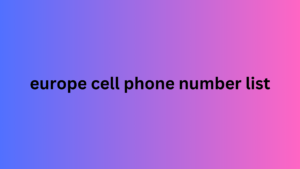Effective anchor text optimization is a cornerstone of successful SEO. When properly utilized, it enhances your content’s visibility, drives targeted traffic, and improves search engine rankings, especially for long-tail keywords. Here’s a detailed guide to mastering anchor text optimization for better long-tail keyword results.
1. Understanding Anchor Text and Its Role in SEO
Anchor text is the clickable, hyperlinked text that directs users to another webpage. Search engines use it as a contextual signal to determine what the linked page is about. When targeting long-tail keywords europe cell phone number list, anchor text becomes even more critical because these specific, multi-word phrases cater to niche audiences and often have less competition in search results.
Optimizing anchor text for long-tail keywords helps improve your chances of ranking for these terms. It also enhances user experience by connecting readers to highly relevant content.
2. Types of Anchor Text to Use for Long-Tail Keywords
There are several types of anchor text the role of anchor text in long-tail keyword seo, each serving unique purposes in SEO:
- Exact Match: The anchor text includes the exact long-tail keyword.
Example: Linking “how to optimize anchor text for SEO” to a relevant page. - Partial Match: The anchor text contains variations or parts of the long-tail keyword.
Example: “Learn anchor text strategies for better rankings.” - Branded: It uses your brand name alongside long-tail keywords.
Example: “Visit [YourBrand] to master anchor text optimization.” - Generic: General terms like “click here” or “learn more” can be optimized by linking contextually relevant content.
- Latent Semantic Indexing (LSI): These use related terms or synonyms of the long-tail keyword.
Example: “Boost your content visibility with effective hyperlink strategies.”
3. Best Practices for Optimizing Anchor Text
To achieve better long-tail keyword results de cell number, follow these optimization strategies:
- Keep it Natural: Avoid stuffing exact-match keywords into every anchor text. Over-optimization can trigger penalties from search engines.
- Diversify Anchor Text: Use a mix of exact match, partial match, and LSI keywords. This ensures a natural link profile and prevents over-reliance on a single type of anchor text.
- Prioritize Relevance: Ensure the linked content aligns with the anchor text. Misleading links can harm user trust and SEO rankings.
- Maintain Contextual Flow: Integrate anchor text seamlessly into the content to enhance readability and user experience. Forced or awkward links disrupt the flow and appear spammy.
- Target User Intent: Choose anchor text that aligns with what the user wants to achieve. For long-tail keywords, understanding specific intent (e.g., informational, navigational, or transactional) is key.
4. Common Mistakes to Avoid in Anchor Text Optimization
- Overuse of Exact-Match Keywords: This can lead to search engine penalties and a poor user experience.
- Irrelevant Linking: Avoid linking unrelated content just for SEO purposes.
- Using Generic Phrases Excessively: Overusing phrases like “click here” wastes an opportunity to provide context.
- Ignoring Mobile Users: Ensure links are easy to click on mobile devices to cater to this growing audience segment.

